Finding a suitable TeamViewer alternative for your Linux system can feel like navigating a maze, especially with the plethora of options available, each touting unique features and functionalities. Instead of bombarding you with specific names, let’s delve into the key factors you should consider, empowering you to make an informed decision tailored to your needs.
Think About Your Use Case:
- Remote Control for Tech Support: If you’re often troubleshooting issues for family or friends, you’d need a solution prioritizing ease of use. Look for features like unattended access (allowing connections even without someone present on the other end) and simple connection setups that don’t require fiddling with firewalls or complex configurations.
- Collaborative Work: For seamless teamwork, features like file transfer, shared clipboard, and even multi-user sessions become crucial. Imagine working on a document together in real-time, making edits and sharing ideas – that’s the power of collaborative remote access.
- Cross-Platform Compatibility: In today’s interconnected world, chances are you’re working with people using different operating systems. Ensure your chosen solution supports not just Linux but also Windows, macOS, and perhaps even mobile platforms for true flexibility.
Prioritize Security and Performance:
- Robust Encryption: Security should be paramount when granting remote access to your devices. Look for solutions employing end-to-end encryption, ensuring your data remains private and protected from prying eyes.
- Speed and Responsiveness: Lag can be a major hindrance during remote sessions, especially for tasks requiring quick reflexes like gaming or graphic design. Prioritize solutions known for their performance optimizations and minimal latency for a smooth experience.
Don’t Underestimate Open-Source Power:
The open-source world offers compelling alternatives often packed with features rivaling commercial counterparts. These solutions often benefit from a vibrant community of developers constantly improving the software and providing support. Embrace the transparency and flexibility of open-source options.
Beyond the Basics:
Consider these additional factors to fine-tune your choice:
- Mobile App Availability: Remotely accessing your computer from your phone or tablet can be incredibly convenient. Check if the solution offers mobile apps and their functionality.
- Meeting and Presentation Features: Some solutions go beyond basic remote control, offering integrated tools for online meetings, presentations, and even remote printing.
- Pricing: While many excellent free and open-source options exist, some premium features might require a subscription. Evaluate your budget and the value proposition offered by paid solutions.
Remember, the “best” solution is subjective and depends entirely on your unique requirements. By carefully considering these factors, you can confidently navigate the world of TeamViewer alternatives for Linux and choose the perfect tool to empower your remote access needs.
The 10 Best TeamViewer Alternatives for Linux in 2024
Looking for a TeamViewer alternative on Linux? Check out these top options!
1. RealVNC
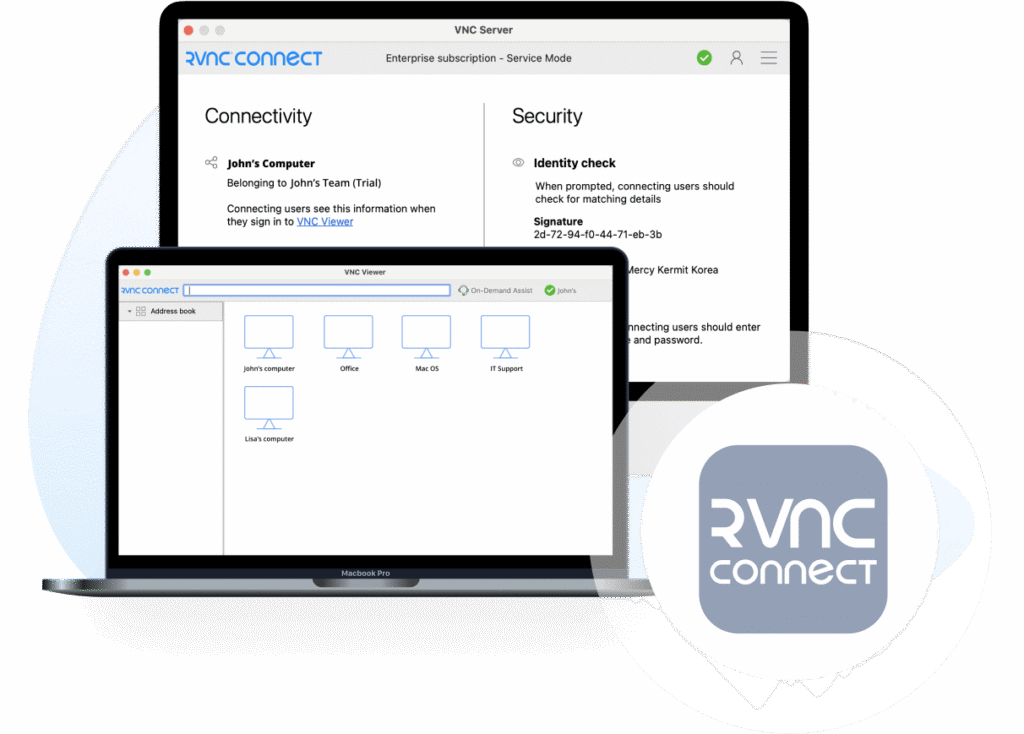
RealVNC emerges as a strong contender in the realm of remote desktop software, holding its own against giants like TeamViewer, particularly for Linux users. Let’s delve into what makes RealVNC tick and why it’s garnered such a positive reputation as a top TeamViewer alternative in 2024.
At its core, RealVNC provides robust and secure remote access and control over computers. Imagine yourself effortlessly accessing your Linux machine from another room, another city, or even another continent – that’s the power RealVNC puts at your fingertips.
Here’s a breakdown of what makes it shine:
- Cross-Platform Compatibility: RealVNC throws a wide net, supporting not just various Linux distributions but also Windows, macOS, iOS, and Android. This versatility ensures you can connect to and manage devices across your ecosystem regardless of their operating system.
- Security First Approach: In an age where data breaches are a constant concern, RealVNC prioritizes security. It employs end-to-end encryption, ensuring your data remains private and protected during transmission. Additional features like two-factor authentication add an extra layer of security, safeguarding your devices from unauthorized access.
- Performance Optimized for Efficiency: No one enjoys laggy remote sessions. RealVNC understands this and has optimized its software for smooth performance. Whether you’re troubleshooting a technical issue, collaborating on a project, or even engaging in light gaming, RealVNC strives to provide a fluid and responsive experience.
- Flexibility for Diverse Needs: RealVNC caters to a wide range of use cases. Its features extend beyond basic remote control, encompassing:
- File Transfer: Seamlessly move files between devices, eliminating the need for cumbersome workarounds.
- Remote Printing: Print documents directly from the remote computer to your local printer – a true productivity booster.
- Chat Functionality: Communicate with the person on the other end, making troubleshooting or collaboration much smoother.
- Deployment Options for Every Scenario: RealVNC offers both cloud-based and self-hosted deployment options. The cloud option provides quick setup and easy accessibility, while self-hosting gives you complete control over your data and server infrastructure.
- Dedicated Linux Support: Unlike some competitors with a primary focus on Windows, RealVNC demonstrates a strong commitment to Linux. This dedication translates to a more polished and optimized experience for Linux users.
- Free Version for Personal Use: RealVNC understands the importance of accessibility. They offer a feature-rich free version for personal use, allowing you to experience the power of remote access without breaking the bank.
While RealVNC excels in many areas, it’s worth noting that the user interface might feel slightly less modern compared to some competitors. However, this minor drawback is often outweighed by its robust feature set, strong security, and unwavering commitment to the Linux platform.
In conclusion, RealVNC stands tall as a top TeamViewer alternative for Linux in 2024, offering a compelling blend of security, performance, flexibility, and cross-platform compatibility. Whether you’re a home user, a small business owner, or a seasoned system administrator, RealVNC provides the tools you need to embrace the power of remote access.
2. AnyDesk
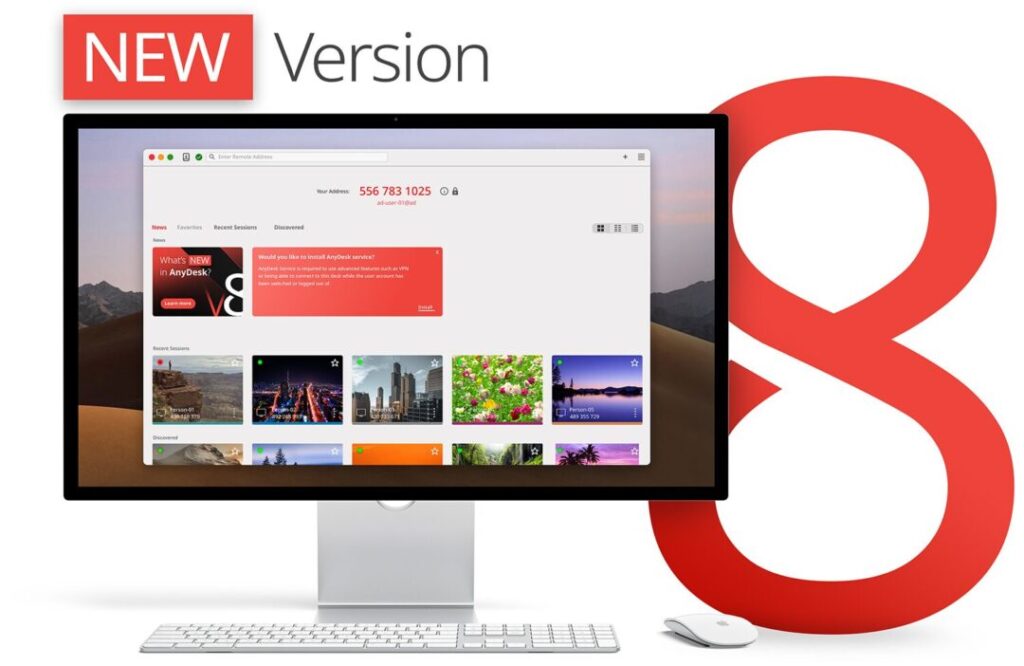
Okay, let’s talk about AnyDesk and why it’s making waves as a top-tier TeamViewer alternative for Linux users in 2024. Imagine this: you need to access your Linux computer, but you’re miles away, maybe even on a different continent. AnyDesk is like that trusty sidekick that teleports you right back to your desktop, no matter where you are.
But what makes it stand out in the crowded world of remote desktop software? Here’s the lowdown:
1. Speed Demon: Seriously, this thing is fast. We’re talking about a buttery-smooth, lag-free experience that often outshines the competition. This speed comes from AnyDesk’s secret weapon: the DeskRT codec. It’s a fancy piece of technology that compresses and transmits data with incredible efficiency, even over those frustratingly slow internet connections. Whether you’re gaming, editing videos, or providing real-time tech support, AnyDesk keeps things snappy.
2. Fort Knox Security: In a world where data breaches are a growing concern, AnyDesk takes security seriously. They use bank-grade TLS 1.2 encryption to create a secure tunnel for your data, ensuring that your remote sessions are shielded from prying eyes. And if that’s not enough, you get additional layers of protection like two-factor authentication and customizable security settings. Think of it as having multiple locks on your digital front door.
3. Lightweight Champion: Nobody wants clunky software bogging down their system, especially on older or less powerful Linux machines. That’s where AnyDesk shines. It’s incredibly lightweight, using minimal system resources even during demanding remote sessions. Plus, it plays nicely with a wide range of operating systems, including Windows, macOS, iOS, and Android. So, no matter what devices your friends, family, or colleagues are using, AnyDesk can bridge the gap.
4. User-Friendly Interface: Let’s face it, not everyone is a tech whiz. AnyDesk understands this and welcomes users with a clean, modern, and incredibly intuitive interface. Connecting to a remote machine is as easy as pie – just enter the AnyDesk address or choose from a list of recent connections, and boom, you’re in! No complicated setup, no confusing menus, just pure remote access bliss.
5. Unattended Access for Ultimate Flexibility: Ever wished you could access your computer even when nobody’s home? AnyDesk makes it a reality with its unattended access feature. It’s like having a virtual key that grants you access anytime, anywhere. Simply enable unattended access on your trusted devices, and you can connect to your Linux machine remotely, even if it’s unattended.
6. Customization is King: AnyDesk knows that one size doesn’t fit all when it comes to remote access. That’s why they give you a toolbox full of customization options. Fine-tune the display settings for optimal viewing on different screens, set permissions for remote users, and tweak the software to perfectly match your workflow.
7. Free Trial for the Curious: Want to take AnyDesk for a spin before committing? No problem! They offer a feature-packed free version for personal use, so you can experience the speed, security, and convenience firsthand. It’s a great way to see if AnyDesk is the right fit for your remote access needs.
While AnyDesk excels in many areas, it’s worth noting that some users find the free version limited for commercial use, and unlocking the full potential of its advanced features often requires a paid subscription. However, the combination of blazing-fast performance, robust security, user-friendliness, and cross-platform compatibility makes AnyDesk a compelling choice for both individuals and businesses seeking a powerful and reliable TeamViewer alternative in 2024.
3. Remmina
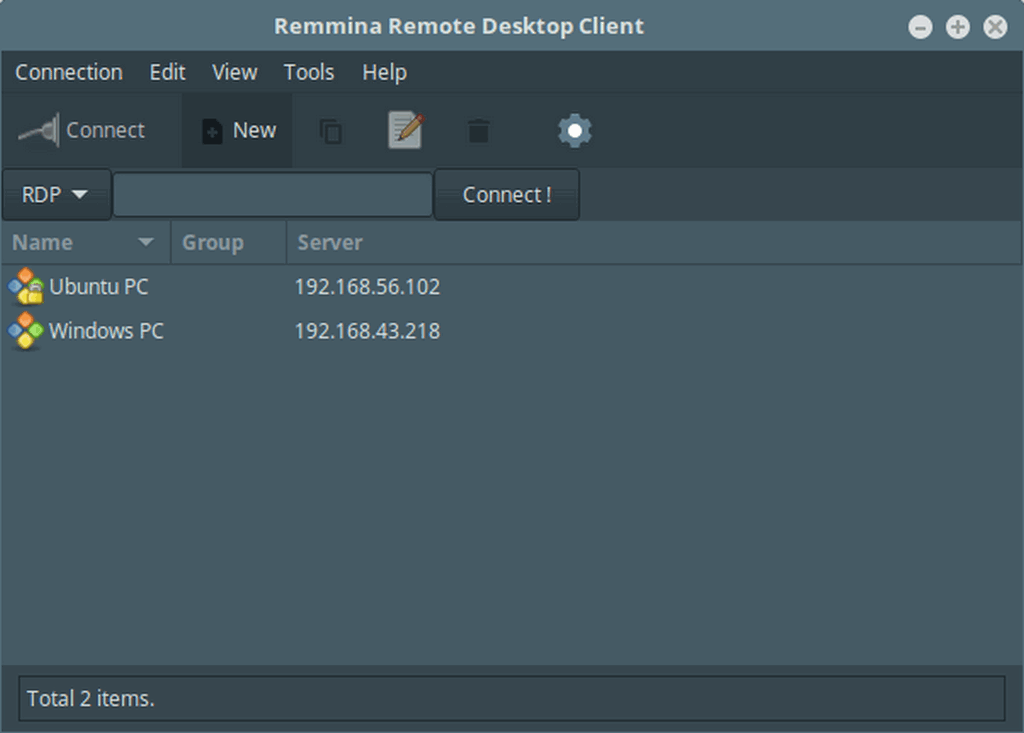
While not as widely known as TeamViewer, Remmina is indeed a fantastic remote desktop tool, especially for Linux users. It’s a bit like discovering a hidden gem – powerful, versatile, and perfectly at home in the Linux world.
Here’s why Remmina deserves serious consideration as a top TeamViewer alternative in 2024, especially for those who love their Linux machines:
1. Open Source and Free as in Freedom:
One of Remmina’s biggest strengths is its open-source nature. It’s completely free to use, modify, and distribute, making it a favorite among developers and privacy-conscious users. No need to worry about subscription fees or feature limitations – Remmina puts the power in your hands.
2. Built for Linux, At Home Everywhere:
Remmina is a true citizen of the Linux world, built using GTK+ and seamlessly integrated into most Linux desktop environments. But don’t let that fool you into thinking it’s a one-trick pony. Remmina supports a wide range of remote desktop protocols, meaning you can connect to Windows, macOS, and even Raspberry Pi devices without breaking a sweat.
3. Protocol Powerhouse:
Speaking of protocols, Remmina isn’t playing around. It supports all the heavy hitters, including:
- RDP: Connect to Windows machines with ease.
- VNC: Control remote computers from various operating systems.
- SSH: Securely access remote terminals for command-line tasks.
- NX: High-performance remote desktop protocol for demanding applications.
- SPICE: Optimized for virtualized environments.
This versatility makes Remmina a true all-rounder, capable of handling almost any remote desktop scenario you can throw at it.
4. Lightweight and Fast:
Remmina is all about efficiency. It’s designed to be lightweight and consume minimal system resources, ensuring a smooth and responsive experience even on older or less powerful hardware. This makes it an ideal choice for users who value speed and performance.
5. User-Friendly Interface:
While Remmina might not win any beauty contests, its interface is clean, straightforward, and easy to navigate. Creating new connections is a breeze, and all the essential features are readily accessible.
6. Active Development and Community Support:
Remmina benefits from an active development community that’s constantly working on improvements, bug fixes, and new features. This means you can expect regular updates and a vibrant community forum where you can find help, share tips, and connect with fellow users.
A Few Considerations:
While Remmina is an excellent choice for many, it’s worth noting that its interface might feel a bit spartan compared to more polished commercial alternatives. Additionally, some advanced features might require a bit more technical know-how to configure.
Overall, Remmina is a fantastic option for Linux users seeking a powerful, versatile, and free remote desktop solution. Its open-source nature, extensive protocol support, lightweight design, and active community make it a compelling alternative to TeamViewer, especially for those already comfortable in the Linux environment.
4. TightVNC
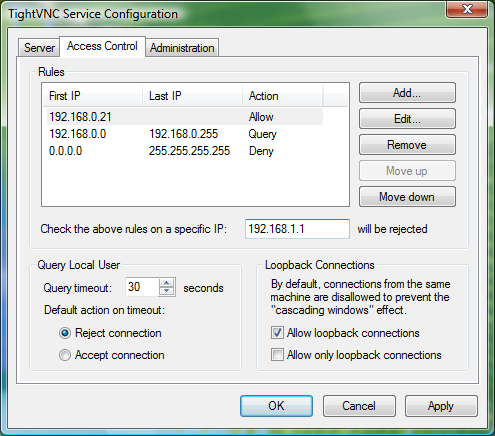
While TeamViewer reigns supreme for many, Linux users seeking a streamlined and secure remote access solution often find themselves looking elsewhere. Enter TightVNC, a free and open-source powerhouse that’s carved its niche as a top TeamViewer alternative in 2024. But what makes this software tick, and why should it be your go-to for remote access on Linux? Let’s delve deeper.
Built for Efficiency, Made for Linux: Unlike resource-hungry alternatives, TightVNC prioritizes efficiency. Its featherweight design keeps your Linux system running smoothly, even on older machines. This translates to a responsive and lag-free experience during remote sessions, ideal for tasks like:
- Quick File Transfers: Need to grab that crucial document from your home PC while you’re at the office? TightVNC lets you navigate your Linux machine’s file system with ease, facilitating swift file transfers.
- Remote System Administration: Manage your Linux servers remotely. TightVNC allows you to monitor system performance, troubleshoot issues, and configure settings – all from the comfort of your own workstation.
- Technical Support on the Go: Imagine a colleague stuck with a technical hurdle on their Linux machine. TightVNC empowers you to remotely access their system, diagnose the problem, and provide real-time assistance, regardless of your location.
Open-source Advantage: Transparency and Power: TightVNC’s open-source nature unlocks several advantages. The readily available source code allows for:
- Customization: Tailor TightVNC to your specific needs. Advanced users can modify the code to add features, integrate with existing workflows, or optimize performance for unique use cases.
- Stronger Security: Open-source software benefits from public scrutiny. Developers around the world can identify and address vulnerabilities, potentially leading to a more secure solution compared to closed-source alternatives.
- Vibrant Community: A thriving community of developers fuels TightVNC’s ongoing development. You gain access to a wealth of resources like tutorials, bug fixes, and platform compatibility updates, ensuring a continually evolving and well-supported experience.
Security You Can Trust: Remote access is only as good as its security. TightVNC employs industry-standard encryption protocols like VNC Secure (VPNC) or Advanced Encryption Standard (AES) to safeguard data transmission during remote sessions. Additionally, features like password authentication and session logging add layers of access control, ensuring only authorized users can access your Linux machine.
Beyond the Walls of Linux: TightVNC transcends the boundaries of your Linux environment. It boasts seamless compatibility with Windows, macOS, and even mobile platforms like Android and iOS. This cross-platform flexibility allows you to connect to and control your Linux machine from virtually any device. Picture this: you’re on vacation, and a critical server issue arises back home. With TightVNC on your smartphone, you can remotely access the server, diagnose the problem, and potentially implement a fix – all without breaking a sweat.
Simple Setup, User-friendly Experience: TightVNC doesn’t require a PhD in IT to get started. The installation process is straightforward, and the user interface is designed for intuitive navigation. Connecting to a remote machine is as simple as entering the IP address or hostname and providing the necessary credentials. This user-friendly approach makes TightVNC ideal for beginners or anyone who prioritizes a streamlined remote access experience.
Tweak it to Your Taste: While primarily focused on core functionality, TightVNC offers some customization options to tailor it to your workflow. You can adjust settings like color depth, screen resolution, and data compression levels to optimize the experience for your specific connection speed and bandwidth limitations. This empowers you to find the perfect balance between visual clarity and performance.
Free and Community-driven: As a free and open-source software, TightVNC is a budget-friendly option for individuals and businesses alike. This eliminates licensing costs often associated with commercial alternatives. But the benefits extend beyond cost savings. The active TightVNC community provides invaluable resources such as well-maintained documentation, comprehensive tutorials, and dedicated forums for troubleshooting and knowledge sharing. This collaborative environment ensures you have access to ongoing support and a wealth of information to maximize your TightVNC experience.
The Bottom Line:
TightVNC shines as a compelling TeamViewer alternative for Linux users in 2024. Its focus on efficiency, robust security features, and user-friendly design make it a strong contender. While it might lack some advanced features found in commercial options, its open-source nature, thriving community, and free-to-use model make it a valuable asset for anyone seeking a reliable and secure remote access solution for their Linux environment. So, if you’re looking for a lean, mean, remote access machine that won’t break the bank, TightVNC might just be your
5. TigerVNC
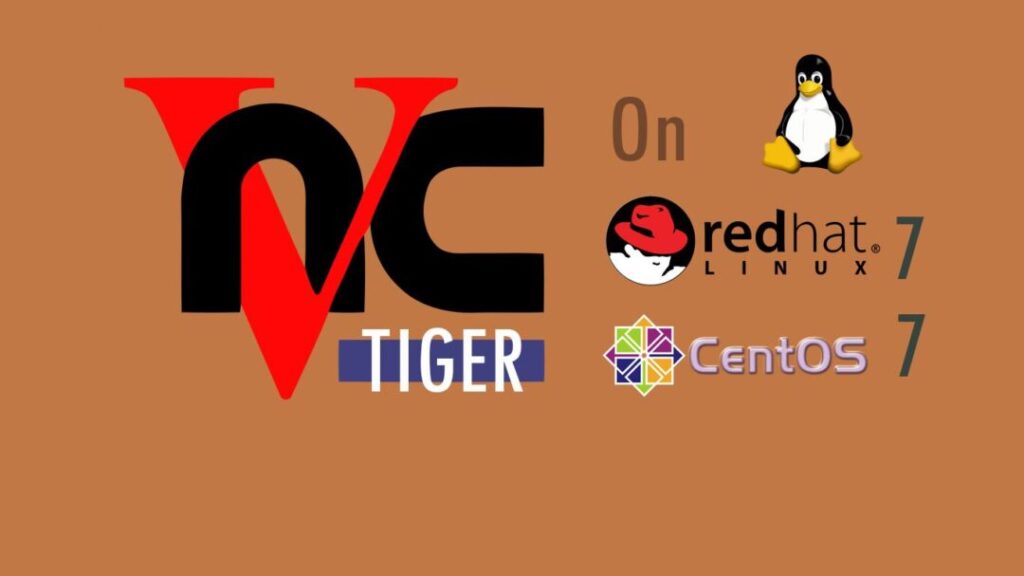
TigerVNC might not have the widespread name recognition of TeamViewer, but for those in the know, especially Linux users, it’s a top contender, and here’s why:
1. Performance That Doesn’t Quit:
TigerVNC is built for speed. It takes the VNC (Virtual Network Computing) protocol, known for its simplicity, and injects it with a dose of performance-enhancing magic. We’re talking advanced video compression, clever caching mechanisms, and streamlined data transfer, all working together to deliver a smooth and responsive remote desktop experience. Even over less-than-ideal internet connections, TigerVNC strives to keep things snappy.
2. Security as a Top Priority:
When it comes to remote access, security is paramount, and TigerVNC takes this to heart. It goes beyond basic password protection and offers a range of robust authentication methods to keep your connections safe:
- Unix PAM Integration: Seamlessly integrates with your existing Linux authentication system (Pluggable Authentication Modules) for centralized user management and control.
- Kerberos Support: For enterprise-grade security, TigerVNC supports Kerberos, a system that uses tickets and encryption to verify identities and protect communications.
- SSH Tunneling: Want to encrypt all data traveling between your computer and the remote machine? TigerVNC makes it easy to set up SSH tunneling, adding an extra layer of security, especially crucial when connecting over public networks.
3. Plays Well with Others (Cross-Platform Compatibility):
While TigerVNC feels right at home in the Linux ecosystem, it’s not a one-trick pony. It extends its compatibility to Windows and macOS, allowing you to connect to and manage devices running different operating systems without breaking a sweat.
4. Constantly Evolving (Active Development):
TigerVNC benefits from a dedicated community of developers who are passionate about keeping it at the forefront of remote desktop technology. This means regular updates, bug fixes, new features, and ongoing security enhancements to address emerging threats.
5. The Price is Right (Open Source and Free):
In the spirit of open-source software, TigerVNC is completely free to use, modify, and distribute. This makes it an incredibly attractive option for individuals, businesses, and organizations of all sizes, as there are no licensing fees to worry about. Plus, the open-source nature allows for customization and tailoring to specific needs.
A Few Things to Keep in Mind:
While TigerVNC excels in performance and security, its interface might not win any design awards. It’s functional but leans more towards practicality than visual flair. Also, configuring some of its advanced security features might require a bit of technical comfort.
In Conclusion:
For Linux users seeking a fast, secure, reliable, and free remote desktop solution, TigerVNC is a top contender. Its performance optimizations, robust security features, cross-platform compatibility, active development, and open-source nature make it a compelling alternative to TeamViewer, especially for those who prioritize speed, security, and a no-nonsense approach to remote access.
6. Chrome Remote Desktop
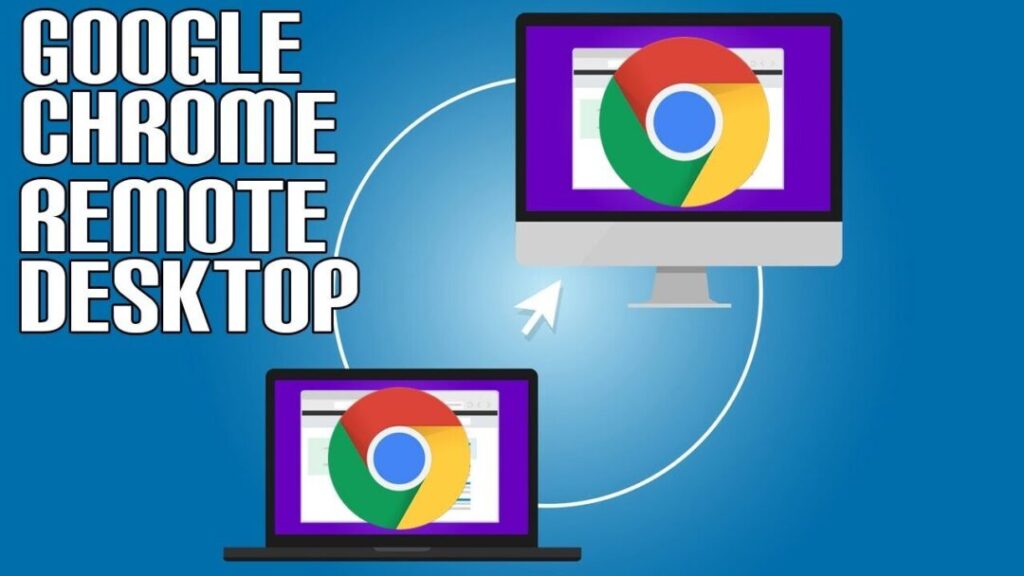
You’re talking about a real contender in the world of remote access! Chrome Remote Desktop often gets overlooked, but for Linux users seeking a simple, reliable, and readily available solution, it’s a fantastic option. Let’s explore why it stands tall as a TeamViewer alternative in 2024:
1. Simplicity at Its Finest:
Chrome Remote Desktop throws complexity out the window and embraces a user-friendly approach. If you can use a web browser, you can use Chrome Remote Desktop. There’s no need to grapple with complicated settings or network configurations. Just install the extension, link your devices, and you’re good to go!
2. Always Within Reach (Cross-Platform Accessibility):
One of Chrome Remote Desktop’s greatest strengths is its seamless cross-platform compatibility. It’s available as a browser extension for Chrome (of course!), as well as dedicated apps for Windows, macOS, Linux, iOS, and Android. This means you can access your devices from virtually anywhere, using whatever device you have on hand.
3. Backed by Google’s Security Muscle:
When you’re granting remote access to your devices, security is non-negotiable. Chrome Remote Desktop benefits from Google’s robust security infrastructure. Connections are protected with end-to-end encryption, ensuring that your data remains private and secure during transmission.
4. No Wallet Required (Completely Free):
In a world of subscription-based software, Chrome Remote Desktop remains refreshingly free. That’s right – you get all these features without spending a dime, making it an incredibly attractive option for individuals, students, and anyone on a budget.
5. More Than Just Screen Sharing:
While Chrome Remote Desktop excels at remote control, it offers a few extra tricks up its sleeve. You can also use it to transfer files between devices seamlessly, making it handy for quickly grabbing a document or sharing photos.
A Few Considerations:
While Chrome Remote Desktop shines in its simplicity and ease of use, it’s not as feature-rich as some paid alternatives like TeamViewer. For example, it lacks advanced features like remote printing, session recording, or the ability to manage multiple remote connections simultaneously.
Overall, Chrome Remote Desktop is a superb choice for Linux users who value simplicity, reliability, and affordability in a remote access solution. Its user-friendly interface, cross-platform compatibility, robust security, and free-of-charge nature make it a compelling alternative to TeamViewer, especially for everyday remote access needs.
7. RustDesk
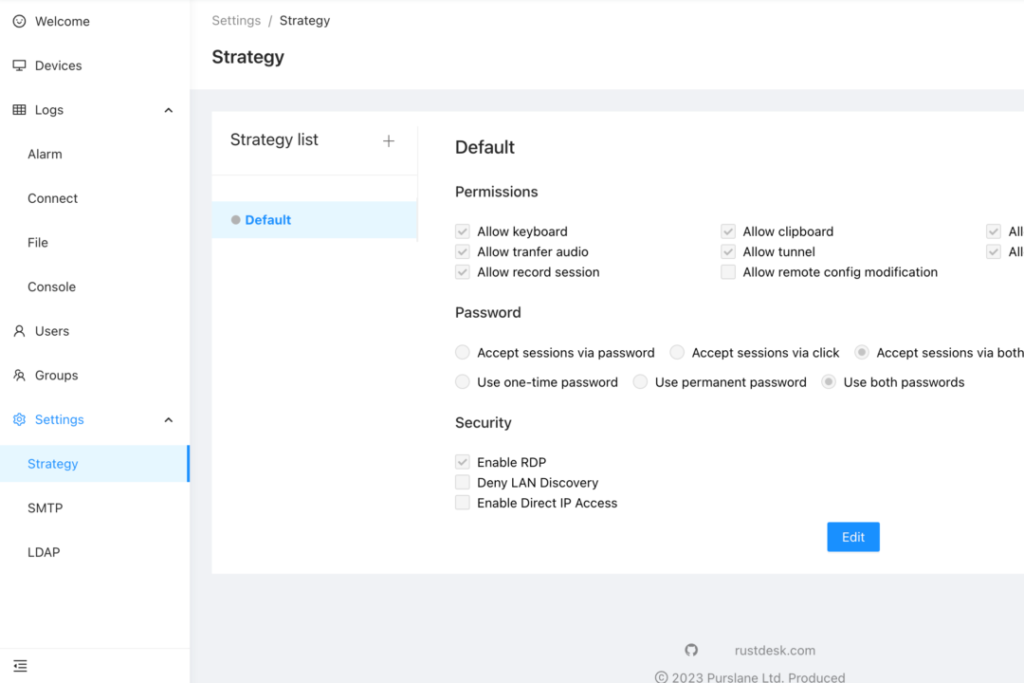
You’re diving into the world of open-source remote desktop champions! RustDesk is like that newcomer who quickly gains respect for its speed, security focus, and commitment to user freedom. Here’s why it’s making waves as a top TeamViewer alternative for Linux in 2024:
1. Built for Speed Demons:
RustDesk takes its name seriously. Developed using the Rust programming language, known for its performance and reliability, RustDesk delivers blazing-fast remote connections. You’ll notice the difference, especially when working with graphically intensive applications or transferring large files.
2. Privacy by Design:
In an age of increasing data concerns, RustDesk puts your privacy front and center. It offers a unique self-hosting capability, meaning you can set up your own relay server, giving you complete control over your data and ensuring that it never touches third-party servers. For those who prioritize data sovereignty, this is a game-changer.
3. Open Source and Auditable:
Being an open-source project means RustDesk’s code is freely available for anyone to examine. This transparency fosters trust, as security researchers can independently verify the software’s integrity and identify any potential vulnerabilities.
4. Cross-Platform Compatibility:
RustDesk doesn’t discriminate. It runs smoothly on Linux, Windows, macOS, iOS, and Android. You can effortlessly connect to and manage devices across different operating systems, making it a versatile solution for both personal and professional use.
5. Feature-Packed and Growing:
Don’t let its newcomer status fool you. RustDesk comes loaded with features:
- Unattended Access: Access your devices remotely, even when no one’s logged in.
- File Transfer: Seamlessly share files between your local and remote machines.
- Multi-Monitor Support: Easily navigate between multiple monitors on the remote device.
- Session Recording: Record your remote sessions for later review or troubleshooting.
A Few Things to Note:
RustDesk’s interface, while functional, is still under active development and might lack the polish of more established alternatives. Also, setting up self-hosting requires some technical know-how.
In Conclusion:
RustDesk is a powerful and promising TeamViewer alternative for Linux users who value speed, privacy, and open-source software. Its performance optimizations, self-hosting capabilities, cross-platform compatibility, and growing feature set make it a compelling choice for those seeking a secure and customizable remote desktop solution.
8. X2Go
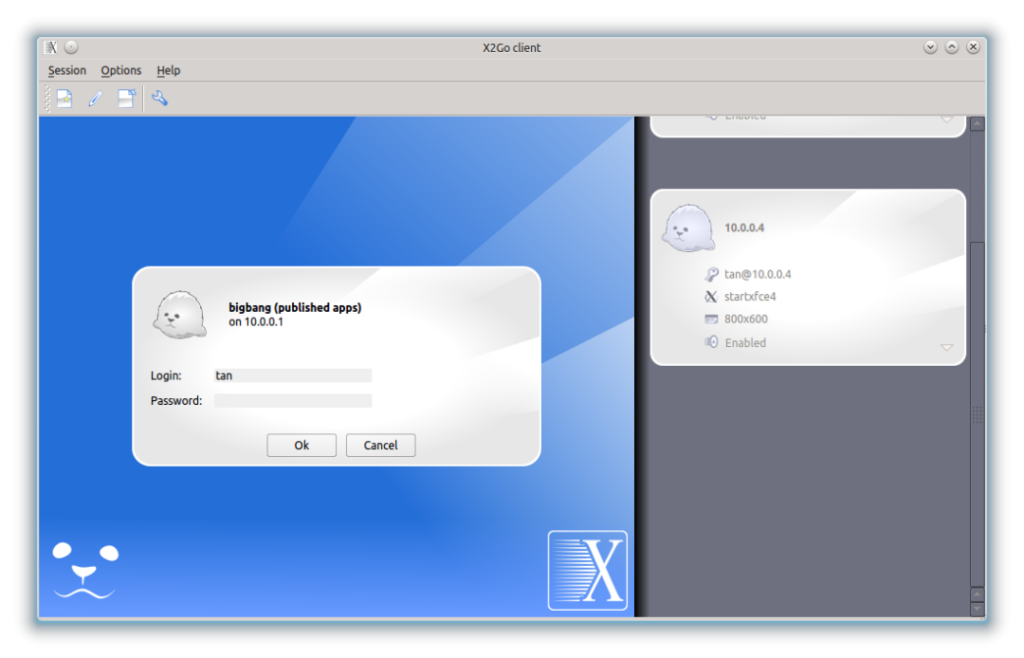
X2Go has been a favorite among Linux enthusiasts for years, and for good reason. It’s known for its speed, minimalist approach, and open-source roots. Let’s explore why it remains a top TeamViewer alternative for Linux in 2024:
1. Built for Speed: A Need for Speed, a Need for X2Go
X2Go prioritizes performance above all else. It uses the NX technology, known for its ability to deliver a smooth and responsive remote desktop experience, even over slower internet connections. If you’re frequently working with graphically intensive applications or transferring large files remotely, X2Go’s speed will be a welcome change.
2. Open Source and Trustworthy:
As an open-source project, X2Go’s code is open for anyone to inspect and audit. This transparency is crucial for security-conscious users, as it allows the community to identify and address potential vulnerabilities. You’re not relying on a black box; you can see exactly how X2Go works.
3. Lightweight and Resource-Efficient:
X2Go is incredibly lightweight, both in terms of its installation size and its resource consumption. It runs smoothly on older hardware and doesn’t bog down your system, making it an excellent choice for users with limited system resources.
4. Seamless Integration with Linux Desktops:
X2Go integrates seamlessly with various Linux desktop environments, including GNOME, KDE, and Xfce. This tight integration provides a more native and familiar experience compared to some other remote desktop solutions.
5. More Than Just Screen Sharing:
While X2Go excels at remote desktop control, it also offers additional features that enhance its versatility:
- Sound Forwarding: Hear the audio from your remote computer on your local machine.
- Clipboard Synchronization: Copy and paste text and files between your local and remote systems.
- Session Sharing: Collaborate with others by sharing your remote desktop session.
A Few Points to Consider:
X2Go’s interface might feel a bit dated compared to some newer alternatives. It also lacks some advanced features found in commercial solutions like TeamViewer, such as built-in file transfer capabilities or mobile device support.
Overall, X2Go remains a solid TeamViewer alternative for Linux users who prioritize speed, security, and a lightweight footprint. Its open-source nature, performance optimizations, and seamless integration with Linux environments make it a compelling choice for a wide range of remote access needs.
9. Apache Guacamole
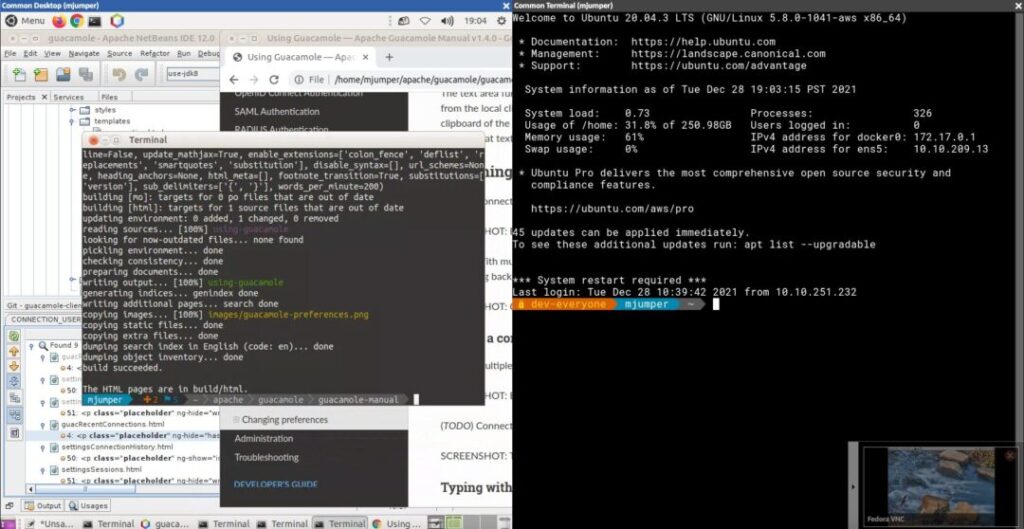
Apache Guacamole is a bit different from your typical TeamViewer alternative, and that’s where its strength lies. It’s a powerful open-source gateway that gives you the flexibility to access and manage a wide range of devices and protocols, all from a single web interface. Here’s why it’s a top contender for Linux users in 2024:
1. Universal Compatibility: One Gateway to Rule Them All
Apache Guacamole’s biggest strength is its unparalleled protocol support. It acts as a central hub, allowing you to connect to devices using various protocols, including:
- VNC (Virtual Network Computing): Control remote desktops and servers.
- RDP (Remote Desktop Protocol): Connect to Windows machines remotely.
- SSH (Secure Shell): Access remote command-line interfaces securely.
- Telnet: Manage network devices remotely.
This versatility makes Guacamole an ideal solution for managing diverse IT environments with multiple operating systems and devices.
2. Enhanced Security: Guarding Your Connections
Security is paramount in remote access, and Guacamole takes it seriously. It acts as a reverse proxy, meaning your remote devices are never directly exposed to the internet. This adds an extra layer of protection, reducing the risk of unauthorized access.
3. Web-Based Convenience: Access From Anywhere
Guacamole is entirely web-based, so you can access your remote devices from any computer or mobile device with a web browser. No need to install client software on every machine – just log in to your Guacamole server, and you’re good to go.
4. Granular Access Control: Manage Who Connects to What
Guacamole provides fine-grained access control, allowing you to manage user permissions and restrict access to specific devices or protocols. You can create user groups, define access levels, and even set session recording policies for enhanced security and auditing.
5. Open Source and Customizable: Tailor It to Your Needs
Being an open-source project, Guacamole is highly customizable. You can modify its source code to add new features, integrate it with your existing authentication systems, or tailor it to your specific workflow requirements.
A Few Things to Keep in Mind:
Setting up and configuring Guacamole can be more involved than using a simpler remote desktop solution like TeamViewer. It requires some technical expertise, especially if you’re dealing with complex network configurations or multiple authentication methods.
In Conclusion:
Apache Guacamole is a powerful and versatile remote access gateway that excels in managing diverse IT environments with its universal protocol support, enhanced security features, and web-based convenience. While it might require some initial setup effort, its flexibility, customization options, and open-source nature make it a compelling TeamViewer alternative for Linux users seeking a comprehensive remote access solution.
10. DWService
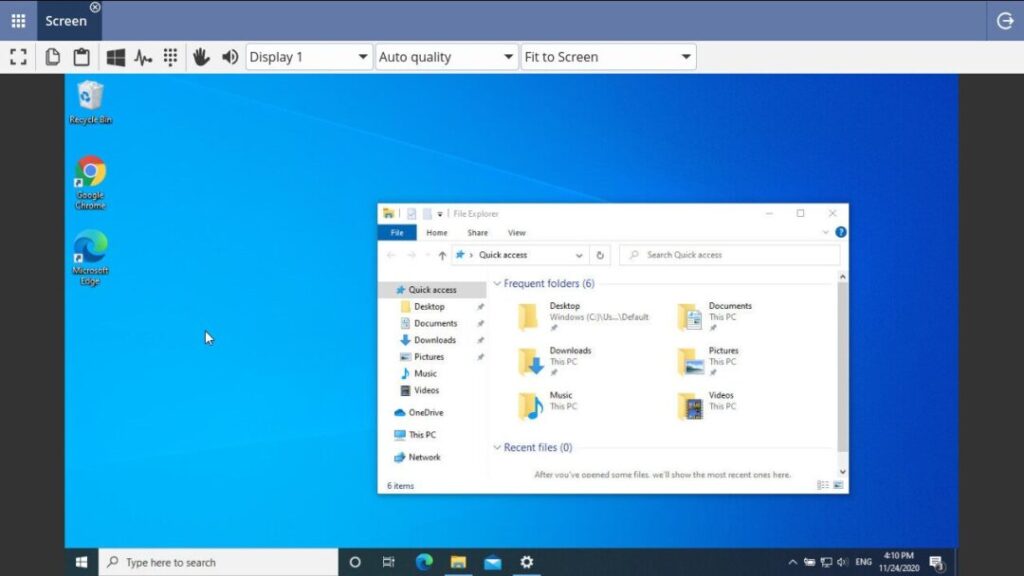
DWService is like that independent friend who sets up their own server because they value control and privacy above all else. It’s a self-hosted remote desktop solution that prioritizes security, simplicity, and ease of use, making it a strong contender for Linux users seeking a TeamViewer alternative in 2024.
1. Self-Hosted Security: Your Data, Your Server
DWService puts you in the driver’s seat when it comes to security. It’s designed to be self-hosted, meaning you install it on your own server, giving you complete control over your data. No third-party servers, no data sharing — just direct, secure connections between your devices.
2. Effortless Setup and Administration:
Don’t let the self-hosting aspect scare you away. DWService is surprisingly easy to set up and manage, even for those without extensive technical experience. It features a user-friendly web interface that simplifies tasks like adding devices, managing users, and configuring access permissions.
3. Lightweight and Cross-Platform:
DWService is designed to be lightweight and resource-efficient, ensuring smooth performance even on older hardware or systems with limited bandwidth. Plus, it supports multiple operating systems, including Linux, Windows, macOS, and even Raspberry Pi, allowing you to manage a diverse range of devices from a single platform.
4. Essential Features for Remote Control:
DWService might be minimalist in its approach, but it doesn’t skimp on the essential features you need for effective remote access:
- Remote Desktop Control: Take full control of remote desktops and servers as if you were sitting right in front of them.
- File Transfer: Seamlessly transfer files between your local and remote machines.
- Clipboard Synchronization: Copy and paste text and data between devices with ease.
- Multiple Monitor Support: Navigate multiple monitors on the remote device without breaking a sweat.
5. Open Source and Community-Driven:
As an open-source project, DWService benefits from a vibrant community of developers and users who contribute to its development, provide support, and share their expertise. This collaborative spirit ensures that DWService remains secure, up-to-date, and constantly evolving.
A Few Considerations:
DWService’s feature set, while solid, might not be as extensive as some commercial alternatives like TeamViewer. It lacks advanced features like session recording or mobile device support.
In Conclusion:
DWService shines as a TeamViewer alternative for Linux users who prioritize self-hosting, security, and ease of use. Its straightforward setup, cross-platform compatibility, and focus on essential remote access features make it an excellent choice for individuals and businesses looking for a reliable and privacy-focused remote desktop solution.
Conclusion: Finding the Perfect Remote Desktop Fit for Your Linux Needs
The world of remote desktop software for Linux offers a plethora of options, each with its unique strengths and considerations. From feature-rich commercial solutions to lightweight open-source tools, the ideal choice depends on your specific workflow and priorities.
Carefully consider the factors discussed throughout this article:
- Security: Unwavering security is paramount. Look for robust encryption protocols, multi-factor authentication, and granular access controls to safeguard your data.
- Performance: Laggy connections can be a productivity nightmare. Choose tools known for their performance efficiency, especially for bandwidth-intensive tasks.
- Ease of Use: A user-friendly interface is key for a seamless experience. Prioritize intuitive controls, straightforward file transfer mechanisms, and features that enhance your workflow.
- Open Source vs. Proprietary: The open-source route offers transparency and customization, while proprietary solutions might provide dedicated support channels. Choose the path that best suits your comfort level.
- Additional Features: Explore features like multi-monitor support, mobile access, or API integration that can further enhance your remote access experience.
Remember, there’s no single “best” alternative. Research, compare, and leverage the insights provided to find the perfect tool that unlocks the full potential of remote access within your Linux environment. With the right choice, you can work smarter, collaborate more efficiently, and stay connected – regardless of physical location.
Don’t hesitate to delve deeper into the options that pique your interest. Explore user reviews, online communities, and official documentation to gain a comprehensive understanding of each tool’s capabilities. Happy remote accessing!



